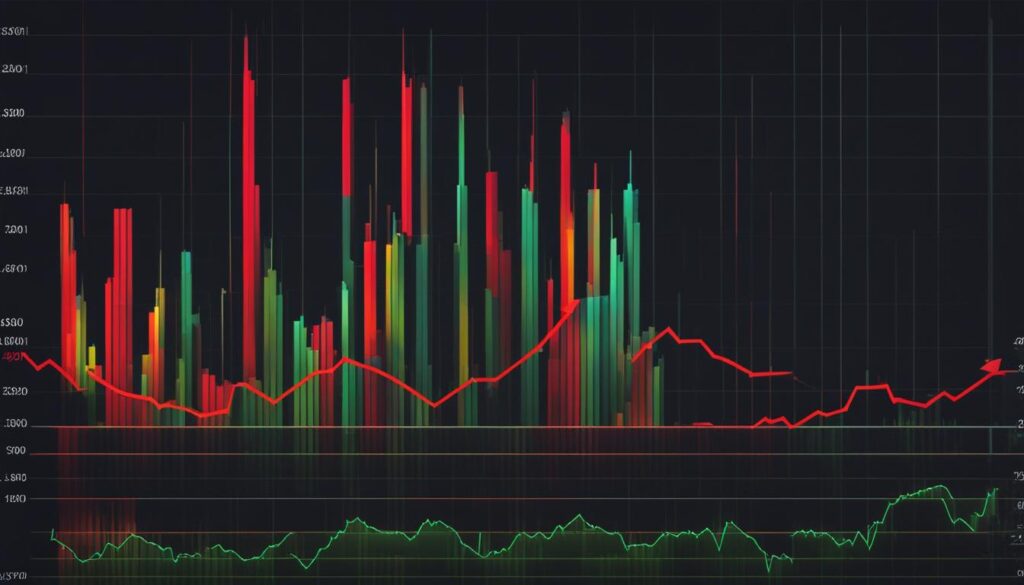Value investing is a strategy that allows investors to uncover market opportunities in undervalued stocks. By analyzing a company’s financial statements, earnings reports, and other relevant data, value investors can determine the true worth of a stock. This approach focuses on finding stocks that are trading below their intrinsic value, providing potential opportunities for long-term growth and profitability.
Key Takeaways:
- Value investing involves seeking out undervalued stocks.
- Analyzing a company’s financial statements and other data is crucial to determine the true worth of a stock.
- Undervalued stocks offer potential opportunities for long-term growth and profitability.
- Value investors utilize various metrics, such as the Price-to-Earnings (P/E) ratio and Price-to-Book (P/B) ratio, to evaluate potential investments.
- Investing in undervalued stocks can help manage investment risk and potentially achieve more stable returns over time.
Understanding Price-to-Research Ratio
The Price-to-Research Ratio (PRR) is a valuable tool in the world of value investing. This ratio allows investors to assess the relationship between a company’s market price and its research and development (R&D) spending. By analyzing the PRR, investors can identify undervalued companies that may have significant growth potential.
Undervalued companies are those whose market prices do not accurately reflect their true worth. These companies often allocate a significant portion of their resources to R&D, investing in innovation and technological advancements. However, their stock prices may not fully reflect the potential value that these investments could generate in the future.
The PRR is calculated by dividing a company’s market capitalization by its R&D expenses. This ratio provides insight into how much the market is currently valuing a company’s research and development efforts. A lower PRR suggests that the market is underestimating the potential value of the company’s R&D investments, indicating that the stock may be undervalued.
To better understand the concept, consider the following example table:
| Company | Market Capitalization | R&D Expenses | Price-to-Research Ratio (PRR) |
|---|---|---|---|
| Company A | $50 million | $10 million | 5x |
| Company B | $100 million | $30 million | 3.33x |
| Company C | $80 million | $20 million | 4x |
In this table, Company B has the lowest PRR of 3.33x, indicating that the market is assigning a lower value to its R&D efforts compared to its peers. This may signal that Company B is an undervalued stock with potential for growth.
By utilizing the Price-to-Research Ratio, value investors can identify undervalued companies that may offer significant long-term opportunities for growth and profitability. It is an essential metric to consider when evaluating investment options and uncovering market opportunities.
How to Calculate Price-to-Research Ratio?
Calculating the Price-to-Research Ratio (PRR) is a straightforward process that involves dividing a company’s market capitalization by its research and development (R&D) expenses. This ratio provides valuable insights into the relationship between a company’s R&D investment and its market value, helping investors identify potential undervalued stocks.
To calculate the PRR, first determine the company’s market capitalization, which is the total market value of its outstanding shares. This information is readily available through financial websites or stock market databases.
Next, gather the company’s research and development expenses, which can typically be found in its financial statements or annual reports. These expenses reflect the amount of money the company allocates towards innovation and product development.
Finally, divide the market capitalization by the R&D expenses to obtain the Price-to-Research Ratio. A lower PRR suggests that the company’s market value is relatively low compared to its R&D investment, indicating potential undervaluation. Conversely, a higher PRR may indicate overvaluation, as the market may be assigning a higher value to the company’s R&D efforts.
By calculating the Price-to-Research Ratio, investors can gain valuable insights into a company’s potential value as an investment opportunity. However, it is important to consider other factors in conjunction with the PRR, such as the company’s financial health, growth prospects, and competitive landscape, to make informed investment decisions.
The Importance of Finding Undervalued Stocks
Finding undervalued stocks is crucial for value investors as it presents opportunities for potential growth and can help manage investment risk. By identifying stocks that are trading below their intrinsic value, investors can capitalize on future price appreciation and potentially achieve more stable returns over time.
Investing in undervalued stocks offers the potential for significant growth. When a stock is undervalued, it means that the market has not recognized its true worth, providing an opportunity for investors to buy at a lower price. As the market adjusts and recognizes the stock’s value, the price is likely to rise, leading to capital appreciation. This potential for growth can result in substantial returns for value investors who are patient and have a long-term investment horizon.
“The stock market is filled with stocks that are overvalued or priced at fair value. The real opportunities lie in finding those diamonds in the rough, the undervalued stocks with significant growth potential.”
In addition to the potential for growth, investing in undervalued stocks can also help manage investment risk. When stocks are trading below their intrinsic value, there is typically a margin of safety. This means that even if the stock’s price decreases in the short term, there is less downside risk compared to stocks that are already trading at high valuations. The margin of safety provides a buffer and helps protect investors from significant losses.
Value investors use various metrics, such as the Price-to-Earnings (P/E) ratio and Price-to-Book (P/B) ratio, to identify undervalued stocks. These metrics help determine if a stock is trading below its fair value. By analyzing these metrics and conducting thorough research, investors can uncover hidden gems in the market and potentially achieve superior investment results.

Key Metrics to Consider in Value Investing
When evaluating potential investments, value investors should consider key metrics such as:
- Price-to-Earnings (P/E) Ratio: This ratio compares a company’s stock price to its earnings per share. A lower P/E ratio may suggest that a stock is undervalued, as investors are paying less for each unit of earnings.
- Price-to-Book (P/B) Ratio: This ratio compares a company’s stock price to its book value per share. A P/B ratio below 1 indicates that the stock is trading below its book value, potentially making it an attractive investment.
- Dividend Yield: This ratio compares a company’s annual dividend payment to its stock price. A higher dividend yield may indicate that a stock is undervalued, as investors are earning a higher return on their investment through dividends.
These metrics, along with an analysis of a company’s financial health, growth prospects, and industry trends, can help value investors identify undervalued stocks that have the potential for long-term growth.
Key Metrics to Consider in Value Investing
When it comes to value investing, there are several key metrics that investors should consider in order to evaluate potential investments. These metrics provide valuable insights into a company’s financial health, growth prospects, and potential for long-term value creation. By analyzing these metrics alongside other factors, investors can identify undervalued stocks that have the potential to generate attractive returns over time.
P/E Ratio
The Price-to-Earnings (P/E) ratio is a widely used metric in value investing. It compares a company’s stock price to its earnings per share (EPS), providing investors with an indication of how much they are paying for each dollar of earnings. A low P/E ratio may suggest that a stock is undervalued, as investors are paying less for its earnings relative to the market average. However, it is important to consider the industry and company-specific factors when interpreting the P/E ratio, as a high or low ratio may not always indicate value.
P/B Ratio
The Price-to-Book (P/B) ratio is another key metric used in value investing. It compares a company’s stock price to its book value per share, which represents the net value of its assets minus its liabilities. A low P/B ratio may indicate that a stock is undervalued, as investors are paying less for its net assets relative to the market price. However, it is important to consider the industry and the company’s specific circumstances when analyzing the P/B ratio, as a high or low ratio may not always reflect the true value of a stock.
Dividend Yield
Dividend Yield is a metric that measures the annual dividend income of a stock relative to its market price. Dividends are a portion of a company’s earnings that are distributed to shareholders, and a high dividend yield may indicate that a stock is undervalued, as investors are receiving a higher return on their investment through dividends. However, it is important to consider the sustainability and growth potential of a company’s dividends when evaluating the dividend yield.
| Metric | Definition | Significance |
|---|---|---|
| P/E Ratio | Compares stock price to earnings per share | Indicates how much investors are paying for earnings |
| P/B Ratio | Compares stock price to book value per share | Indicates how much investors are paying for net assets |
| Dividend Yield | Measures annual dividend income relative to market price | Indicates return on investment through dividends |
These key metrics, along with comprehensive financial analysis, provide investors with a holistic view of a company’s value and potential for future growth. It is important to consider these metrics in conjunction with other factors, such as a company’s competitive position, management team, and industry dynamics, to make well-informed investment decisions. By utilizing these metrics effectively, value investors can identify undervalued stocks and position themselves for long-term success in the market.
Conclusion
Value investing is a proven long-term strategy for investors looking to uncover market opportunities and achieve sustainable growth. By focusing on undervalued stocks, value investors can potentially benefit from future price appreciation and mitigate risks. However, it’s important to understand the potential challenges and risks associated with this approach.
Patience and discipline are key when practicing value investing. It requires conducting thorough financial analysis and understanding the true worth of a company. This strategy is not about short-term gains, but rather about identifying long-term value.
While value investing can be rewarding, investors should be aware of potential risks, such as falling into value traps or succumbing to behavioral biases. Value traps occur when a stock appears undervalued but lacks the potential for future growth. Behavioral biases, such as herd mentality or emotional decision-making, can also impact investment outcomes.
Therefore, value investors should exercise caution, constantly evaluate their investment decisions, and diversify their portfolios. By following these principles and remaining committed to a long-term strategy, value investing can provide opportunities for growth and help investors achieve their financial goals.
FAQ
What is value investing?
Value investing is a strategy that involves seeking out undervalued stocks by analyzing a company’s financial statements, earnings reports, and other data to determine its true worth.
What is the Price-to-Research Ratio (PRR)?
The Price-to-Research Ratio (PRR) is a metric used in value investing to compare a company’s current market price to its research and development (R&D) spending.
How is the Price-to-Research Ratio calculated?
Calculating the Price-to-Research Ratio involves dividing a company’s market capitalization by its research and development expenses.
Why is finding undervalued stocks important?
Finding undervalued stocks is crucial for value investors as it presents opportunities for potential growth and helps manage investment risk.
What are some key metrics used in value investing?
Key metrics in value investing include the Price-to-Earnings (P/E) ratio, Price-to-Book (P/B) ratio, and Dividend Yield.
Is value investing a rewarding strategy?
Value investing can be a rewarding strategy for those willing to put in the effort to uncover undervalued stocks. However, investors should be aware of potential risks and challenges.
How Do Blue-Chip Stocks Provide Stability in the Market?
Investing in blue-chip stocks for stability is a wise move, as these stocks belong to well-established companies with a strong financial track record. Their market presence and brand recognition provide a certain level of stability. Blue-chip stocks are often considered safer investments due to their ability to weather economic downturns, making them suitable for risk-averse investors seeking stability in the market.
Source Links
- https://fastercapital.com/content/Value-investing–Uncovering-Undervalued-Stocks-using-PricetoResearchRatio.html
- https://www.investopedia.com/articles/fundamental-analysis/09/five-must-have-metrics-value-investors.asp
- https://richardabbe.com/value-investing-finding-undervalued-stocks-for-long-term-growth/


Pingback: Growth Stocks: Identifying Companies with High Potential for Capital Appreciation – Straight Fire Money